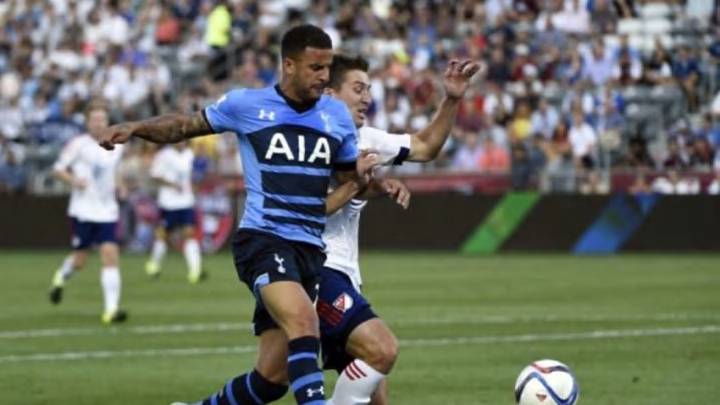In the small crowd of Spurs stars who are turning in standout seasons, Kyle Walker might be the dimmest.
It’s not because he hasn’t been a good as the likes of Dele Alli or Eric Dier or Toby Alderweireld – far from it – but rather because the role of right-back compared to those other more central positions is less evidently vital.
There have been games where Walker’s improved defensive game has made the difference. Swansea and Southampton come to mind. That he’s managed to improve that aspect of his game while also continuing to surge forward to stretch defenses and provide an outlet pass the midfield is among the more impressive upgrades of any Spurs player so far this season.
Many have cited the arrival of Burnley right-back Kieran Trippier as the primary motivator for Walker to up his game. That’s not wrong, but it fails to take into account the fact that Walker’s ‘slump’ last term was mostly framed by two injuries at the beginning and end of season. That, combined with adapting to Mauricio Pochettino’s new system, was always going to slow Walker down.
More from Hotspur HQ
- Storybook ending after difficult period for Tottenahm’s Richarlison
- Tottenham comeback showcased invaluable intangible Ange has cultivated
- Tottenham player ratings in 2-1 comeback win over Sheffield United
- Tottenham projected starting 11 for Sheffield United
- Tottenham’s Richarlison says he’s going to seek psychological help
To his credit, Walker did the hard work over the summer to hold onto his place in the starting XI, thereby consigning Trippier to Europa League group stage matches.
That was up until the match against Watford. Coming two short days after the Boxing Day win over Norwich, Pochettino elected to rest Walker, instead giving Trippier his first Premier League start for Spurs.
It’s easy to see the logic behind this move. Walker is frequently covering some of the most ground of any Spurs player on the pitch, so resting him amidst a dense holiday fixture schedule only makes sense.
There was more to Trippier’s inclusion however. Pochettino recognized the difficulty other teams have had against Watford’s fairly unique two striker system and thus had Dier drop deep into a centre-back role between Alderweireld and Jan Vertonghen. From a defensive standpoint this broadly worked, even if Watford’s Odion Ighalo managed to sneak one past the trio just before halftime.
Offensively, it meant that Trippier and his counterpart on the left flank, Danny Rose, were pushed up into wing-back roles. Both Walker and Rose tend to more or less function as wing-backs with the ball, but with the added cover behind each other them in the form of the centre-backs, their forays into attack were permitted to happen much more frequently.
On Trippier’s flank, this added ability to attack manifested itself in a number of dangerous crosses into Watford’d penalty box, one of which found Heung-min Son and allowed the South Korean to score Spurs’ winning goal.
That kind of wide play – hugging the touchline in anticipation of sending crosses into the box – is decidedly different than Walker’s style.
Take a look at the comparison between Walker’s match against Norwich on the left and Trippier’s against Watford on the right.

Walker is clearly more interested in connecting with the midfield and cutting inside when in possession, while Trippier’s concerns are higher up the pitch, particular out wide.
Part of this comes down to that three-at-the-back formation Spurs’ played against Watford, but it’s also a question of mentality. Trippier was still able to track back and defend when called upon while still presenting a unique threat to Watford’s defense from his deep crosses. Even if the majority of them were accurate or were cut off by Watford’s centre-backs, it kept the pressure up throughout the match.
Pochettino might have recognized the benefits of this kind of play from Trippier, though understandably fell short of dropping Walker in favor of the ex-Burnley man in this past week’s match against Everton.
That said, there’s some evidence that Walker upped his wide game in response to how effective Trippier looked. Here is the Statszone comparison between his game against Norwich and his game against Everton.

He stayed wider against Everton, concentrating his efforts in Everton’s half and pinning Leighton Baines back in a broad attempt to pull Everton’s compact defense wide.
None of those efforts led to any meaningful advantage over Everton – at least not from a production standpoint – but they did help Spurs keep their width. If there’s one criticism leveled at Pochettino’s team, it’s been that it can often play too narrowly. The recent switch to a vague front three of Harry Kane, Alli and Érik Lamela threatened to only exacerbate this issue. It makes sense then that Pochettino might instruct Walker to incorporate a bit of Trippier’s wider play in order to balance Spurs’ play out across the pitch.
Next: Tottenham are Interested in a Peterborough United Player
This recent advent might begin to pay dividends fairly soon. Spurs’ opponent over the next two games – Leicester City – are famously narrow in defense, a tactic that threatens to crowd the center of the pitch. Walker could be re-discovering his wide game at exactly the right time.
